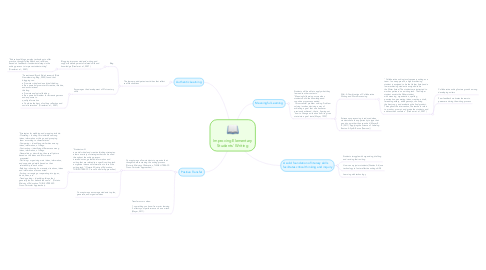
1. Authentic Learning
1.1. The learner participates in activities that reflect real-life situations
1.1.1. Blog
1.1.1.1. Blogging improves students’ writing and supports development of related skills and knowledge (Drexler et. al., 2007).
1.1.1.1.1. "Educational blogs employ technology to offer practice, thoughtful feedback, and revisions based on feedback—fundamental steps in the writing process to improve student writing" (Drexler et. al., 2007).
1.1.2. Encourages the development of 21st century skills
1.1.2.1. "Fernette and Brock Eide’s research (Eide Neurolearning Blog, 2005) found that blogging can: • Promote critical and analytical thinking • Be a powerful promoter of creative, intuitive, and associational thinking • Promote analogical thinking • Be a powerful medium for increasing access and exposure to quality information • Combine the best of solitary reflection and social interaction" (Drexler et. al., 2007).
2. Positive Transfer
2.1. Concept maps allow students to organize their thoughts before starting the writing process (Ontario Ministry of Education, THINK LITERACY: Cross-Curricular Approaches).
2.1.1. "Students will: • model critical and creative thinking strategies. • learn a variety of strategies that can be used throughout the writing process. • reread notes, gathered information and writing that are related to a specific writing task. • organize ideas and information to focus the writing task." (Ontario Ministry of Education, THINK LITERACY: Cross-Curricular Approaches).
2.1.1.1. "Strategies for webbing and mapping include: -Clustering – looking for similarities among ideas, information or things, and grouping them according to characteristics. -Comparing – identifying similarities among ideas, information, or things. -Contrasting – identifying differences among ideas, information, or things. -Generalizing – describing the overall picture based on the ideas and information presented. -Outlining – organizing main ideas, information, and supporting details based on their relationship to each other. -Relating – showing how events, situations, ideas and information are connected. -Sorting – arranging or separating into types, kinds, sizes, etc. -Trend-spotting – identifying things that generally look or behave the same." (Ontario Ministry of Education, THINK LITERACY: Cross-Curricular Approaches).
2.1.2. Concept maps encourage students to plan, generate, and organize ideas
2.2. Transfer occurs when: 1. something you know from prior learning 2. affects your performance on a new task. (Mayer, 2011).
3. Meaningful Learning
3.1. Students will be able to apply what they learned to other contexts. "Meaningful learning occurs when students build the knowledge and cognitive processes needed for successful problem solving. Problem solving involves devising a way of achieving a goal that one has never previously achieved; that is, figuring out how to change a situation from its given state into a goal state (Mayer, 1992)"
3.1.1. Wiki: A Combination of Collaborative Writing and Word Processing
3.1.1.1. "Collaborative writing involves peers writing as a team. In one approach, a higher achieving student is assigned to be the Helper (tutor) and a lower achieving student is assigned to be the Writer (tutee). The students are instructed to work as partners on a writing task. The Helper student assists the Writer student with meaning, organization, spelling, punctuation, generating ideas, creating a draft, rereading essays, editing essays, choosing the best copy, and evaluating the final product. Throughout the intervention, the teacher’s role is to monitor, prompt, and praise the students, and address their concerns." (Graham et. al., 2007).
3.1.1.1.1. Collaborative writing fosters growth among developing writers
3.1.1.1.2. Peer feedback motivates learners to persevere during the writing process
3.1.2. Extraneous processing is reduced when students have the opportunity to type their good copy rather than re-write it (Mayer, R. E. (2011). Applying the Science of Learning. Boston: Allyn & Bacon (Pearson)).
